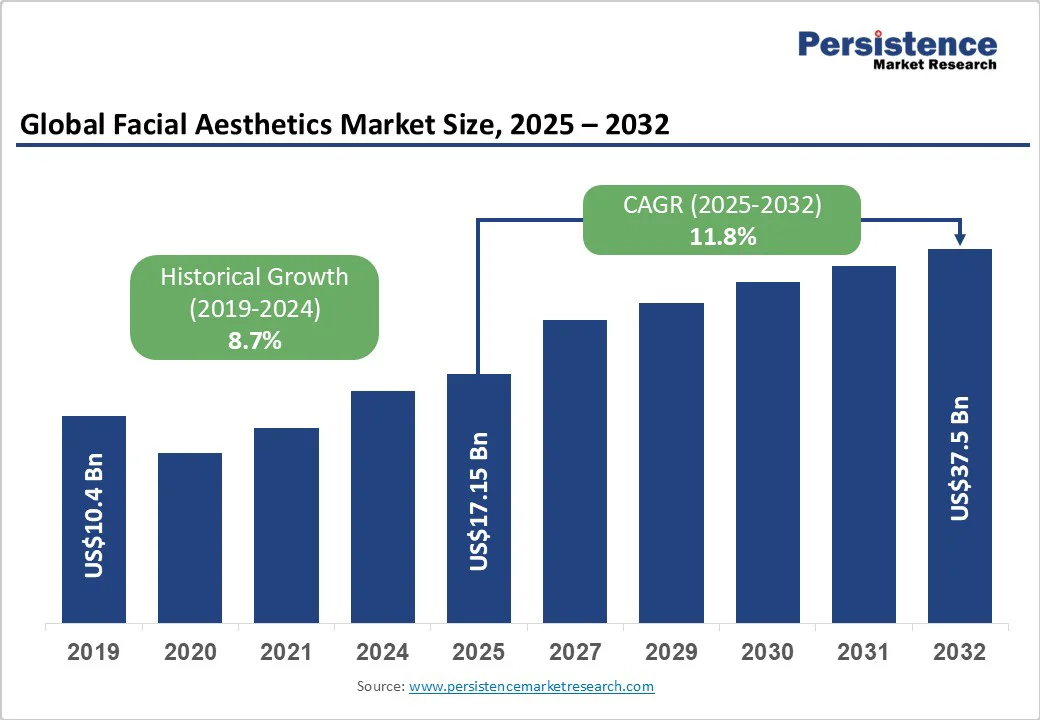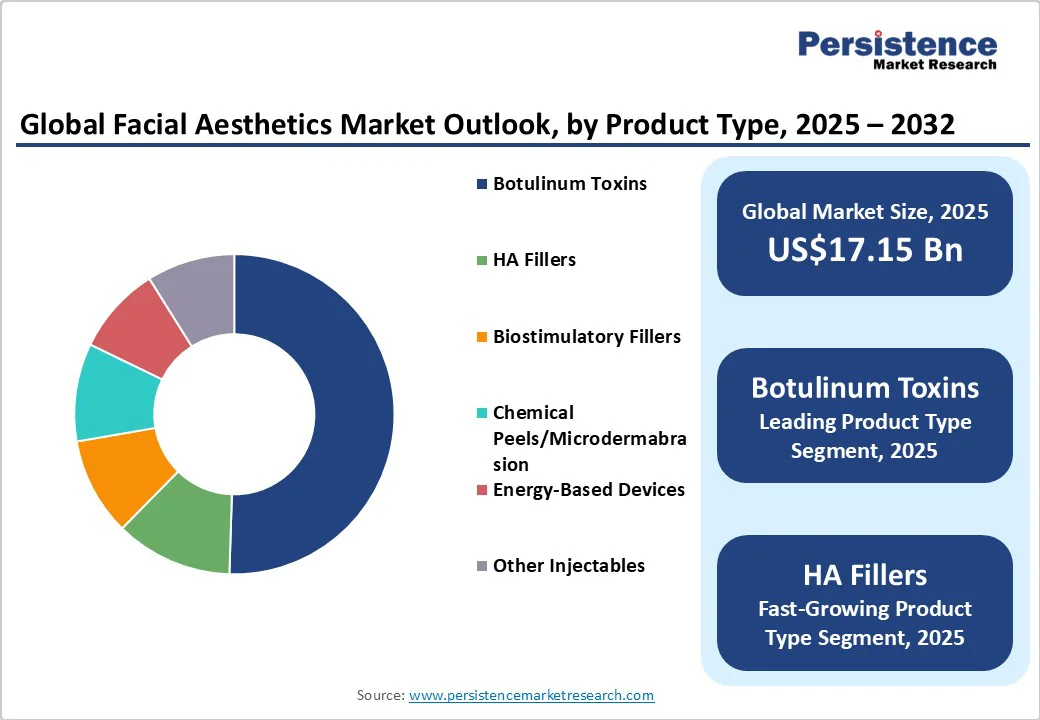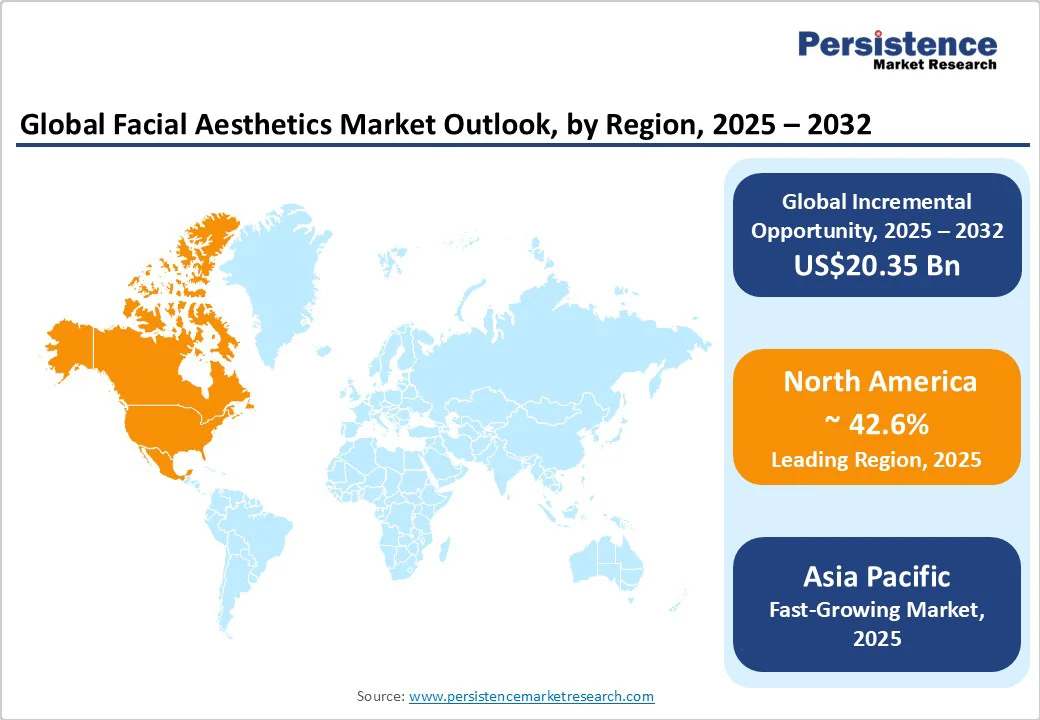ID: PMRREP23479| 218 Pages | 13 Oct 2025 | Format: PDF, Excel, PPT* | Healthcare

The global facial aesthetics market size is likely to be valued at around US$17.15 Billion in 2025, and expected to reach US$37.5 Billion by 2032, growing at a CAGR of 11.8% during the forecast period from 2025 to 2032, driven by the rising adoption of minimally invasive procedures such as botulinum toxins and dermal fillers, coupled with demographic shifts, including aging populations and increasing demand for prejuvenation among younger consumers.
Technological innovations, including longer-lasting injectables and combination therapy protocols, are expanding the market for these treatments. Increased disposable incomes in emerging regions and strategic product launches by major manufacturers further strengthen market growth.
| Key Insights | Details |
|---|---|
| Facial Aesthetics Market Size (2025E) | US$17.15 Bn |
| Market Value Forecast (2032F) | US$37.5 Bn |
| Projected Growth (CAGR 2025 to 2032) | 11.8% |
| Historical Market Growth (CAGR 2019 to 2024) | 8.7% |

Global patient preference is increasingly shifting toward non-surgical facial procedures due to reduced downtime and predictable outcomes. Botulinum toxins and hyaluronic acid fillers account for the majority of procedure volumes, with high repeat usage rates. This segment drives recurring sales and clinic traffic, significantly increasing revenue per patient and expanding the overall market.
Aging populations in developed markets create demand for corrective treatments, while younger cohorts increasingly pursue prejuvenation procedures. This dual demographic effect broadens the total addressable market and accelerates patient adoption, supporting higher procedure volumes and expanding clinic revenue.
The development of longer-lasting neuromodulators, biostimulatory fillers, and integrated device-biologic protocols enhances patient outcomes and expands procedural indications. Innovation raises the average revenue per treatment and shortens adoption cycles in high-income markets, contributing to sustained market growth.
Fragmented regulatory frameworks across regions, including the FDA, EMA, and PMDA, increase time-to-market and approval costs. Limited reimbursement for elective procedures heightens consumer sensitivity to price, particularly in price-conscious markets, which impacts adoption rates and revenue growth.
Facial aesthetic injectables rely on complex biological manufacturing processes and sterile fill/finish capacity. Disruptions in raw material supply and production limitations can constrain inventory and affect launch schedules. Smaller manufacturers are particularly vulnerable to supply chain challenges, creating concentration risk around larger industry players.
Emerging markets in the Asia Pacific are witnessing a rapid adoption of aesthetic procedures due to rising disposable incomes, cultural acceptance, and the growing popularity of medical tourism. Regulatory improvements and local manufacturing initiatives further enhance growth potential. Market penetration in APAC is expected to increase significantly, representing a substantial revenue opportunity by 2032.
Recurring treatments, especially neuromodulators, allow clinics to implement subscription-based programs and loyalty initiatives. Such models increase lifetime patient value, reduce acquisition costs, and stabilize revenue streams. Widespread adoption could generate billions of dollars in incremental revenue across leading markets by 2032.
Botulinum toxins remain the largest product segment in the market, accounting for over 51.4% of total injectable revenue. These neuromodulators are widely used for wrinkle reduction and facial line correction, including glabellar lines, forehead lines, and crow’s feet.
Established brands, such as BOTOX (Allergan) and Daxxify (Revance/Crown Labs), maintain strong clinician preference due to consistent results, brand trust, and extensive training programs. Regular repeat treatments and high patient retention contribute to sustained revenue growth.
HA fillers are experiencing rapid growth. These products are increasingly being adopted for volume restoration in the cheeks, temples, and jawlines, as well as for lip augmentation and subtle contouring. Innovations such as combination treatments with skin boosters and regenerative serums, along with label expansions for new indications, are driving higher adoption rates, especially in high-income and trend-conscious markets.
Clinics and medspas account for the largest share of the market, generating 48.9% of the global revenue in 2025. These facilities offer a wide range of minimally invasive treatments, including botulinum toxins, HA fillers, and chemical peels, often bundled with skin care services.
Popular examples include Skinney Medspa in North America and Soho House Aesthetic Clinics in Europe. The repeated nature of treatments, loyalty programs, and premium service offerings sustains high revenue per patient and strong market penetration.
Hospital-affiliated outpatient centers and multi-specialty dermatology practices are rapidly increasing their market presence. These facilities leverage patient trust and institutional credibility to offer advanced procedures, including neuromodulators, volumizing fillers, and energy-based treatments such as laser resurfacing.
Examples include Cleveland Clinic Aesthetic Dermatology in the U.S. and Charité University Hospital Dermatology in Germany. Cross-referrals and the ability to perform complex multi-modality treatments are driving faster growth in this segment compared to traditional medspas.
Neuromodulator treatments for wrinkle reduction, such as glabellar lines, forehead lines, and crow’s feet, constitute the largest application segment by volume and revenue. Treatments using BOTOX, Daxxify, and Dysport are widely adopted globally, with strong repeat patient cycles supporting sustained revenue. Clinics often combine neuromodulator injections with chemical peels or microdermabrasion to enhance results, making this application a staple of facial aesthetics practice.
Volume restoration procedures are experiencing the fastest growth due to rising awareness of facial aging patterns, post-weight-loss volume loss, and the influence of social media aesthetics. Advanced HA fillers and biostimulatory agents such as Sculptra (PLLA) and Restylane Lyft are increasingly used for cheek and temple augmentation, jawline contouring, and lip enhancement. Growth is also fueled by innovative treatment combinations with regenerative serums and energy-based devices, appealing to consumers seeking longer-lasting, natural-looking results.

North America remains the largest market for facial aesthetics, accounting for approximately 42.6% of the global revenue in 2025. High per-capita procedure volumes, early adoption of innovative treatments, and robust disposable incomes drive market dominance.
The U.S. leads the region with a well-established regulatory framework under the FDA, ensuring safety and efficacy standards for neuromodulators, dermal fillers, and energy-based devices. Mature clinician networks, advanced loyalty programs, and strong digital marketing initiatives support high patient engagement and repeat visits.
Recent developments include the expansion of private equity-backed aesthetic clinic chains such as SkinSpirit Medspa and Ideal Image, consolidating regional market share and creating standardized care protocols. Strategic M&A activity, such as Crown Laboratories acquiring Revance Therapeutics, has strengthened neuromodulator portfolios, while digital tele-consultation platforms such as RealSelf and Clever Health enhance patient accessibility and pre-procedure engagement. Technological adoption of next-generation injectables, combination therapies, and AI-guided treatment planning is also accelerating.
Key growth drivers in North America include increasing demand for prejuvenation among millennials, widespread insurance coverage for some reconstructive procedures, and continued innovation in long-lasting neuromodulators and regenerative fillers. Investment trends point toward clinic network expansion, cross-brand partnerships, and integration of AI diagnostics to optimize treatment outcomes.
Asia Pacific is the fastest-growing region in the facial aesthetics market, driven by rising disposable incomes, growing medical tourism, and increased acceptance of aesthetic procedures. South Korea leads in procedural sophistication, particularly for eyelid surgery, facial contouring, and non-invasive injectables.
China offers large-volume demand for neuromodulators and HA fillers, while India is emerging as a hub for cost-competitive treatments and medical tourism. ASEAN countries, including Thailand and Singapore, are also witnessing high adoption due to culturally embedded beauty standards and strong healthcare infrastructure.
Recent regional developments include Restylane launching new biostimulatory fillers in South Korea, Crown Laboratories expanding clinics in China, and AbbVie introducing Daxxify in select Japanese markets, reflecting rapid innovation adoption. E-commerce-to-clinic platforms such as PICOCARE and ZhongAn Aesthetic Health are facilitating online bookings, consultations, and patient education, expanding reach into Tier 2 and Tier 3 cities.
Primary growth drivers include cultural emphasis on aesthetics, increasing influence of social media and K-beauty trends, and greater availability of affordable financing options for elective procedures. Investment trends focus on joint ventures with local distributors, in-country manufacturing of injectables, and the integration of teleconsultation platforms to attract younger, tech-savvy consumers. Regional regulatory improvements and more streamlined approvals for new injectables are further enhancing growth potential.
Europe represents the second-largest market globally, with countries including Germany, the U.K., France, and Spain. The region benefits from harmonized regulatory frameworks, including CE marking for medical devices, which streamlines product approvals across EU member states. Aging populations, increasing private healthcare uptake, and growing medical tourism in countries such as Spain and Turkey contribute to steady demand for minimally invasive procedures.
Recent developments include Merz Aesthetics’ acquisition of facial filler brands in France and Ipsen’s launch of new botulinum toxin formulations in Germany to expand treatment options and clinician adoption. Additionally, several cross-border clinic expansions, such as The Harley Medical Group (U.K.) opening satellite clinics in Germany and Spain, highlight strategic investment flows. Collaborations with cosmetic brands, such as co-marketing campaigns with La Prairie and L’Oréal, have also enhanced brand visibility and patient trust.
Primary growth factors in Europe include higher disposable incomes in Western Europe, regulatory support for safe practice, and the rising popularity of combination therapies integrating neuromodulators with laser treatments. Investment trends focus on consolidating multi-clinic networks, introducing subscription-based treatment models, and expanding into underserved Eastern European markets where consumer awareness is rapidly growing.

The global facial aesthetics market exhibits a concentrated structure in injectables, with a few multinational firms dominating botulinum toxin and filler portfolios. Device and energy-based segments are moderately fragmented. Leading players include AbbVie/Allergan, Galderma, Merz Aesthetics, Bausch Health, Ipsen, and Crown Laboratories.
Leading strategies include product innovation, vertical integration with clinics, channel diversification, and strategic M&A. Firms emphasize clinician education, regulatory compliance, and differentiated service offerings.
The global facial aesthetics market size is estimated at US$17.15 Billion in 2025.
The market is projected to reach US$37.5 Billion by 2032.
The facial aesthetics market is expected to grow at a CAGR of 11.8%, driven by rising adoption of minimally invasive injectables, technological innovations, and expanding clinic networks.
Key trends are increasing demand for non-surgical procedures such as neuromodulators and dermal fillers, and the growth of prejuvenation treatments among younger consumers.
The botulinum toxins segment is the largest product category, accounting for over 51.4% of injectable revenue, widely used for wrinkle reduction and facial line correction.
AbbVie/Allergan Aesthetics, Galderma, Merz Aesthetics, Crown Laboratories / Revance Therapeutics, and Ipsen.
| Report Attribute | Details |
|---|---|
| Historical Data/Actuals | 2019 - 2024 |
| Forecast Period | 2025 - 2032 |
| Market Analysis | Value: US$ Bn |
| Geographical Coverage |
|
| Segmental Coverage |
|
| Competitive Analysis |
|
| Report Highlights |
|
By Product Type
By End-user
By Application
By Region
Delivery Timelines
For more information on this report and its delivery timelines please get in touch with our sales team.
About Author